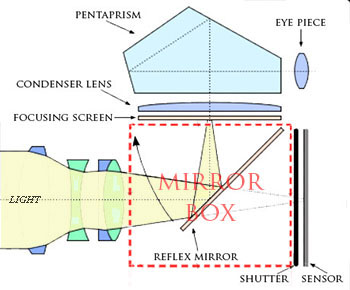Cotton's Guide to Camera Shopping, 2016
Page 2 of 6. Version 1.0, ©2016 by Dale Cotton, all rights reserved.
Mirrorless vs. SLR
SLR, or single lens reflex, was the default camera viewing system during the second half of the 20th century. Essentially an upside-down periscope, it uses a mirror at a 45 degree angle that intercepts the light from the camera lens and reflects it up to a second, smaller mirroring surface that provides the photographer with a real-time view of the scene through a peep hole. SLR is a purely mechanical + optical system that has long since come to maturity.
Mirrorless employs a small but high-res LCD screen, showing a real-time feed from the sensor, that is housed inside the viewfinder. Thus this small LCD stands in place of the direct optical image reflected by the mirror system in an SLR. The best SLR viewing experience, or OVF (optical viewfinder), remains visually superior to the best EVF (electronic viewfinder) experience. EVFs still have very slightly more black-out time between shots and a very slight lag time that make them unsuitable of extremely fast, erratic action, such as many types of sports and wildlife. EVFs can also have trouble providing a bright-enough scene in strong daylight for eyeglass wearers due to light-leak in the gap between eyeglass lens and eyeball.
EVFs shine, however, when compared to less-than-best OVFs, and have some key advantages over even the best OVFs. The apparent size of an EVF image is not scaled to the sensor size but can be made as large as the biggest SLR finder image. EVFs include all shooting data overlaid on the scene if desired. Most importantly, you see whether your current exposure setting is too dark or too bright before you take the shot, not after. Real-time, or WYSIWYG, exposure is a beautiful thing.
A second key area of difference between SLR and mirrorless is in auto focus (AF). SLR AF is a mature tech that still has an edge for sports and wildlife shooting, as well as in very low light. For any other scenario the best mirrorless AF, if slightly slower, is more accurate, covers more of the scene, and offers optional perqs like eye-tracking.
A third set of differences follow directly from mirror vs. mirrorless. An SLR camera necessarily has a large cubical chamber, called the mirror box, between the lens and the film or sensor plane to accomodate the mirror's travel between its position when in use and its position when retracted to allow a picture to be taken.
Removing that chamber permits the design of a smaller camera body, while also removing a complicating factor in lens design called retro-focus (displacing the plane of focus past the intervening mirror box). A smaller camera body is less intimidating, so somewhat better suited when trying to get unposed shots of people and animals. Often, however, the lens is so big that the difference in camera body size becomes moot. In fact, a larger camera body helps balance the heft and torque of a large, protruding lens. Removing the mirror box might also seem to make for a lighter-weight camera, but the difference there is marginal. Apparently, the mirror box is also a significant manufacturing cost. If so, the savings implicit in mirrorless is not being passed on to the consumer.
Removing the mirror box also means that lenses from any SLR brand can be used on any mirrorless camera body provided an adapter is available. Some functionality is often lost in doing this, especially in the area of auto focus.
A less-obvious difference between SLR and mirrorless is in operational sound. Taking a photo typically involves some mechanical activities that have a sound signature. The retraction of the mirror prior to exposure creates a sound (not to mention a vibration) called mirror slap. The motion of the shutter creates a sound. The sound of an SLR in use can be problematic, such as during a ceremony or in a museum or when doing wildlife photography. Mirrorless is inherently quieter. Plus, the most recent mirrorless models often offer an all-silent mode, using an electronic rather than a physical shutter. (Be aware that there are limitations inherent in electronic shutter tech.)
Yet another difference between SLR and mirrorless: the all-electronic operation of a mirrorless camera can chew through battery power more quickly than SLR does. Plus, manufacturers typically use a physically smaller battery in mirrorless. Upshot: a typical EVF mirrorless gets maybe 300 shots per battery charge. A typical SLR gets three times that.
In sum, both mirrorless and SLR have a pretty much equal mix of strengths and weaknesses. SLR remains the choice for serious sports and wildlife work. Mirrorless has the advantage of real-time exposure presentation. The best SLRs have the advantage of an unparalleled viewfinder experience. Mirrorless can be the smaller, lighter, and more discrete option – but only when combined with smaller lenses. Lenses grow in size when opting for: zoom instead prime, very long or very short focal lengths, larger maximum apertures, and stabilized over non-stabilized. To retain the size and weight advantage of mirrorless, one pretty much needs to stick to lenses in the 28 to 100 mm focal range together with a F/3.5 or smaller max aperture range. (28-100 is in full frame or 35mm film terms. For APS-C think 18-150 mm, and for micro 4/3rds think 14-100 mm.)

